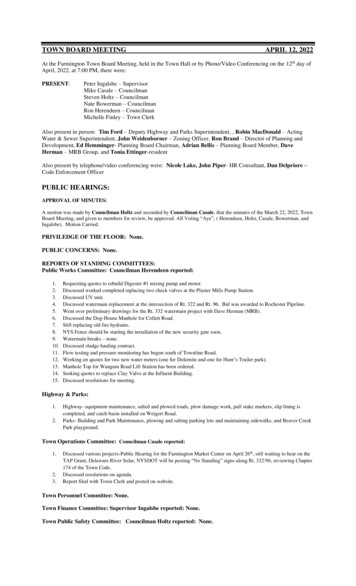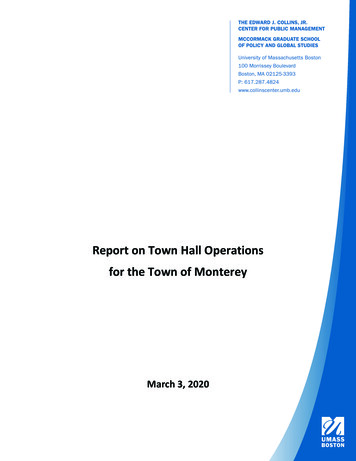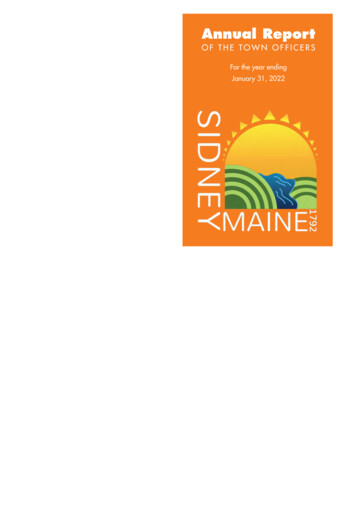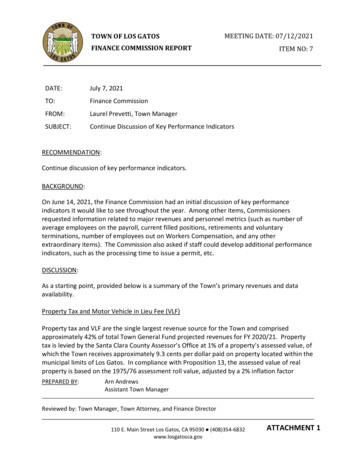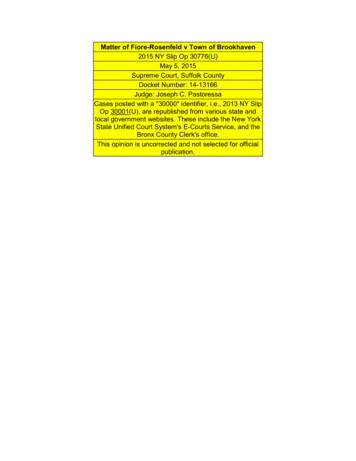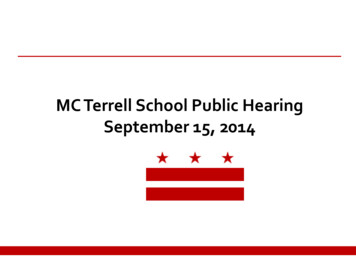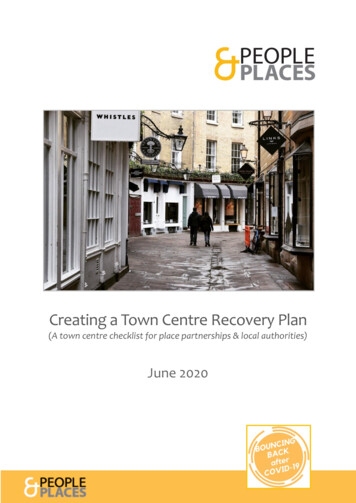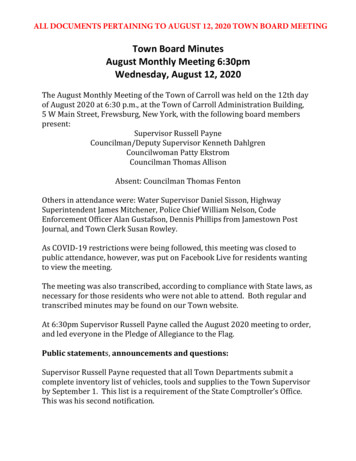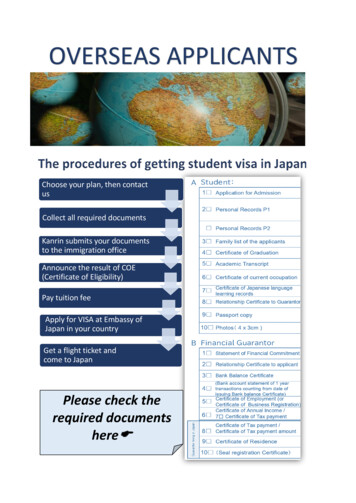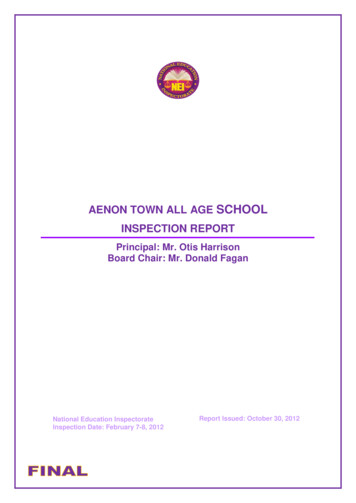
Transcription
AENON TOWN ALL AGE SCHOOLINSPECTION REPORTPrincipal: Mr. Otis HarrisonBoard Chair: Mr. Donald FaganNational Education InspectorateInspection Date: February 7-8, 2012Report Issued: October 30, 2012
TABLE OF CONTENTSPageIntroduction . 1Key Questions . 1The Five-point Scale . 2Consistency in terminology . 2Profile . 3School’s Demographics . 3Socio-economic Context . 3Executive Summary . 4Overall effectiveness of the school . 4Findings of School Inspection . 61) School Leadership and Management . 62) Teaching Support for Learning . 73) Students’ Academic Performance . 84) Students’ Academic Progress . 105) Students’ Personal and Social Development. 116) Use of Human and Material Resources . 127) Curriculum and Enhancement Programmes. 138) Student Safety, Security, Health and Wellbeing . 14RECOMMENDATIONS . 16Further Action . 16List of Abbreviations and Acronyms . 17Appendices . 18Appendix 1 - Record of Inspection Activities . 19Appendix 2 - Inspection Indicators. 20Appendix 3 - National Test Data . 39iiNational Education Inspectorate May 2013School Inspection Report
IntroductionThe National Education Inspectorate (NEI) is responsible for making an assessment of thestandards attained by the students in our primary and secondary schools at key points duringtheir education. It is the aim of the NEI to report on how well students perform or improve, asthey progress through their schooling and learning life. The NEI is also charged with theresponsibility to make recommendations to support improvement in the quality of the provisionand outcomes for all learners.During school inspections, our trained inspectors observe classroom lessons, interview membersof the school’s staff, students individually and in small groups. Inspectors also look at samples ofstudent work and study various school documents provided before and during the inspection.Additionally, School Inspectors hold meetings with the principal and senior members of the staffto get clarity on their roles and responsibilities at the school.Please see the Inspection Indicators (Appendix 2) used by School Inspectors to assist informing judgements about a school’s progress.Key QuestionsThe inspection indicators are structured as a set of eight key questions that inspectors ask aboutthe educational provision and performance of every school. These are:1. How effectively is the school led and managed by the Board, the principal and seniormanagement team and middle leadership?2. How effectively does the teaching support the students learning?3. How well do students perform in national and/or regional tests and assessments? (Forinfants: in relation to age-related expectations)4. How much progress do students make in relation to their starting points?5. How good is the students personal and social development?6. How effectively does the school use the human and material resources at its disposal tohelp the students achieve as well as they can?7. How well do the curriculum and any enhancement programmes meet the needs of thestudents?8. How well does the school ensure everyone’s security, health, safety and wellbeing?1National Education Inspectorate May 2013School Inspection Report
The Five-point ScaleInspectors make judgements according to a five-point scale. The five levels on the scale aredefined as follows:Level 5– Exceptionally high quality of performance or provisionLevel 4– Good: The expected level for every school. Achieving this level in all aspects ofits performance and provision should be a realistic goal for every schoolLevel 3– Satisfactory: the minimum level of acceptability required. All key aspects ofperformance and provision in every school should reach or exceed this levelLevel 2– Unsatisfactory: quality not yet at the level acceptable for schools. Schools areexpected to take urgent measures to improve the quality of any aspect of theirperformance or provision that is judged at this level. Action on the inspectors’recommendations for improvement is mandatoryLevel 1– Needs Immediate Support: quality is very low. Schools are expected to takeimmediate action to improve the quality of any aspect of their performance orprovision that is judged at this level. Action on the inspectors’ recommendationsfor improvement is mandatory.Consistency in terminologyThe following terms are used consistently throughout the indicators with the following definitions:AllAlmost allMostManySomeFewNone100%90% to 99%75% to 89%50% to 74%21% to 49%1% to 20%02National Education Inspectorate May 2013School Inspection Report
ProfileSchool’s DemographicsLocale:Parish:School Code:Gender:School Organization:Size:Attendance Rate:Capacity:Enrolment:No. of Teachers:Pupil-Teacher Ratio:Owned by:RuralClarendon13001Co-educationalWhole DayClass II85%5003121623:1GovernmentSocio-economic ContextAenon Town All Age School is located in the community of Aenon Town, Clarendon. The schoolwas established in 1891 as an elementary school in the building that was St. Matthews AnglicanChurch’s manse. In later years, it was relocated to the St. Matthews Anglican Church building. Inthe early 1950s, a parcel of land was donated by a benefactor to the government of Jamaica forthe building of the new school. In 1955, the school building was constructed and the schooltransferred to its present location. Since then, the plant has been expanded with the assistanceof The Jamaica Social Investment Fund (JSIF), Sports Development Foundation (SDF) and theschool’s Parent Teacher Association (PTA).Most of the students are from a low socio-economic background and this manifests in the highlevels of illiteracy with which the school must contend. Nonetheless, the students are activeparticipants in a range of activities including cultural, science, and reading competitions.3National Education Inspectorate May 2013School Inspection Report
Executive SummaryOverall effectiveness of the schoolThe overall effectiveness of Aenon Town All Age School is unsatisfactoryLeadership and management is unsatisfactoryThe Principal has a vision for the school but supervision lacks rigour and is inconsistent. Middlemanagement is weak. Plans for school improvement are not well developed and there is nopolicy or practice of school self-evaluation. The Board is actively involved in school operationsand there is support from parents and the community.Teaching and learning is unsatisfactorySome teachers demonstrate that they know their content but most fail to demonstrate how bestto teach it. The teaching methods employed by the teachers lack creativity and are ineffective inengaging the students. Assessment is however not well developed. Some students use theirtime well in lessons and can explain what they have learned.Performance in national tests is unsatisfactoryThe school’s performance in the Grade Four Literacy Test (GFLT) and GNAT language arts wasbelow the national average for 2008 to 2010 while its performance in Grade Six AchievementTest (GSAT) language arts and communication task was either in line with or above the nationalaverage. The Grade Four Numeracy Test (GFNT) results for 2009 to 2011 and GSATmathematics for 2008 to 2011 indicate an improvement in the school’s performance. However,the school’s performance in GNAT mathematics was below the national average for the 2008 to2010 period.Progress in English and mathematics is unsatisfactoryProgress is being made in English lessons at Grades 5 to 9 while only some students are makingadequate progress in mathematics. The progress made by students over time is marginal.Overall, students’ personal and social development is unsatisfactorySome students do not demonstrate positive values and attitudes in lessons or on the compound.Students are given leadership roles through the various clubs operating at the school. Moststudents have a fair understanding of Jamaica’s economic progress and importance, regionallyand globally. The littering of the premises, the poor usage of the facilities and general damage topersonal and school properties show that students fail to practice cleanliness and good hygieneThe school’s use of its human and material resources is unsatisfactoryThere is sufficient teaching staff but insufficient support staff. Most of the teachers are secondarytrained with only five teachers trained in primary education and one in early childhood. Someteachers are assigned subject areas for which they have no training. Material resources in theschool are inadequate and the appropriateness and quality of the school premises areunsatisfactory. Some teachers do not utilize the available resources in the lessons and theavailable space is underutilized.4National Education Inspectorate May 2013School Inspection Report
Curriculum and enhancement programmes are satisfactoryThe school uses the Revised Primary Curriculum (RPC) and the Reform of Secondary Education(ROSE) curriculum to guide instruction in the school. Modifications are made to the mathematicscurricula at Grades 8 and 9. Additionally, the school is involved in the Jamaica CulturalDevelopment Commission (JCDC) competitions and the school’s programmes benefits from thesupport of the local community.Provisions for safety, security, health and wellbeing are satisfactoryThere are clear policies and procedures in place for the safety and security of all concerned.Additionally, the school has adequate provisions for students’ health and wellbeing.Inspectors identified the following key strengths in the work of the school: Provisions for students wellbeingEnthusiastic students who are eager to learnGood support of the parents, the community and agenciesHow effective is the school overall?The overall effectiveness of the school is unsatisfactory5National Education Inspectorate May 2013School Inspection Report
Findings of School Inspection1) School Leadership and ManagementHow effectively is the school led and managed by the Board, the principal andsenior management team and middle leadership?Overall, the school is unsatisfactorily led and managedSchool-based leadership and management is unsatisfactoryThe Principal who has led the school for the last three years is seen as a proactive administrator.He relates well with the Board and most staff members. There is a vision for the school’sdevelopment; however, it is not thoroughly shared with all stakeholders to encourage ownershipof its implementation. Marginal improvement in students’ performance in national tests has takenplace but instructional leadership is inadequate. Consequently, teaching and learning is notrigorous enough to produce the quality of improvement needed.Systems are in place to monitor lesson plans and there is an expected format; however, someteachers do not submit the plans as is required. Additionally supervisor’s feedback to mostlesson plans indicates that they are seen, but without any useful commentary. In someinstances, lesson planning does not demonstrate an appreciation for the match between realisticobjectives and appropriately sequenced learning activities. Further, the systems of accountabilityare not rigorously applied and there is very little to indicate that the teachers are heldaccountable for improving their performance. Record-keeping is also a challenge. One indicatorof this is the Admission Register 2011 to 2012 where only names and dates of birth have beenentered.Self-evaluation and school improvement planning is unsatisfactoryA system of school self-evaluation is not clear or well-developed. Some key stakeholders areunaware of how the process works. Others are aware of some of the strengths and weaknessesthat exist in the areas of literacy and numeracy. Plans for school improvement are notadequately shared and is considered to be the duty of the Principal and Senior Teacher.Consequently, there is no effective monitoring and evaluation of plans that are implemented. ASchool Improvement Plan for 2010 to 2014 is still in its draft stage. Nonetheless, each teacherhas an action plan. Test results are also shared with teachers who are asked to target weakareas; but, this process is not rigorously monitored to ensure that weaknesses are addressed.Governance is satisfactoryMembers of the Board visit the school regularly, sometimes every week. The Board gains itsknowledge and understanding of the school through reports from the Principal at Boardmeetings, observations by Board members, and informal conversations with the Principal. TheBoard holds the school to account for standards, outcomes and spending.Relationship with parents and local community is goodThe school communicates with parents by telephone, letters, reports and word of mouth. Parentsare advised of their children’s progress two times per year when academic reports are6National Education Inspectorate May 2013School Inspection Report
distributed. They are also informed through the schools’ open door policy where parents feelcomfortable to walk in and talk to their children’s teachers. The school makes a deliberate effortto develop parental involvement in their children’s learning and the life of the school by engagingparents in fund raising activities, music, speech and drama club which is headed by a parent,and the Parent Empowerment Programme. In the recent past, the school empowered parentsthrough skills development such as sewing. Parents feel welcome at school, volunteer to makecharts, do fundraising and devotions. The Parent Teacher Association (PTA) has an enthusiasticpresident who is committed to the improvement of the school. In addition, a local church alsoassists with devotions and a past student supports the welfare programme by donating cashmonthly to assist with the provision of meals and resources for students.How effectively is the school led and managed by the Board, the principal and seniormanagement team?1-9GradesSchool-based leadership and managementUnsatisfactorySelf-evaluation and improvement lations with parents and community2) Teaching Support for LearningHow effectively does the teaching support the students’ learning?Overall, teaching in support of learning is unsatisfactoryThe teachers’ subject knowledge and how best to teach the subject is unsatisfactoryMany teachers have a secure understanding of the subjects they teach. Some are confident andable to consistently deliver accurate information to students. Some teachers also ably engagestudents in the lesson. For example, the some used life experiences to teach subject content andengaged students in lessons. In some lessons, however, some teachers failed to demonstratehow best to teach the subject. Some lessons are not stimulating and many students are notmeaningfully engaged in learning. In a few lessons, teachers demonstrate insecure knowledge ofcontent. This was evident in instances of misspelling being passed on to students in a Grade 5English lesson. Additionally, insecure subject knowledge limited the teacher’s ability to effectivelydevelop concepts in a Grade 4 English lesson.The teaching methods are unsatisfactoryThe teaching methods employed by the teachers lack creativity and are ineffective in engagingthe students. There is inconsistency in lesson planning and evaluation of lessons taught. Time isinefficiently managed; as a consequence, the teaching of some lessons is not completed andstudents have unfinished work in their notebooks. Choice of resources for the enhancement oflessons is limited. Resources such as textbooks and visual materials are commonly used but areusually not appropriately used to maximize students’ learning. Most of the teaching strategiesused by teachers across the grades insufficiently challenge and cater to the needs of moststudents. Most of the lessons observed were teacher-centred.7National Education Inspectorate May 2013School Inspection Report
Students’ assessment is unsatisfactoryAssessment is not well developed. Many teachers do not have sufficient knowledge of students’strengths and weaknesses. Assessment as a part of teaching and learning mainly involveschorus responses and activities that do not challenge many students. Assessment feedback forthe most part is without evaluative comments to help students identify and make improvement.Nonetheless, there are some teachers who are aware of the strengths and weaknesses of theirstudents. Some also take the time to incorporate the more academically-challenged students intothe assessment process. Many teachers also circulate the room as students do seat work andmark their books as they work.Student learning is unsatisfactoryMany students use the time allotted for seat work well. Some can explain what they havelearned and can work constructively with others when required. For example, the Grade 6language arts students worked collaboratively and applied learning to real life situationsparticularly in expressing their problem solving skills in writing a letter to a friend in Siberia.Many students were eager to participate in classes and attempted work given during the lessons.However, many students are unable to follow the teacher’s instructions. For instance, in Grade 2mathematics, some students were frustrated in a lesson on telling the time. In Grade 4mathematics, only a few students were able to find the area of a room.How effectively does the teaching support the students learning?1-9GradesTeachers subject knowledge and how bestto teach the subjectUnsatisfactoryTeaching nts learningUnsatisfactory3) Students’ Academic PerformanceHow well do the students perform in national and/or regional tests andassessments?Overall, students’ performance is unsatisfactory in national testsStudents’ performance in English is unsatisfactoryGrade Four Literacy results indicate that the school’s averages fluctuated over the period buttrended upwards. In 2008, the school attained an overall average mastery of 68 per cent. Thiswas one and two percentage points below both national (69 per cent) and regional (70 per cent)averages. In 2009, the school’s average (55 per cent) declined by 13 percentage points. Thiswas 12 and 11 percentage points below both national (67 per cent) and regional (66 per cent)averages. The participation rate for this exam was 86 per cent. In 2010, the school’s average (438National Education Inspectorate May 2013School Inspection Report
per cent) improved by 17 percentage points. This was seven and six percentage points belowthe national (65 per cent) and regional (66 per cent) averages correspondingly. The Grade FourLiteracy target set for each primary level school by the Ministry of Education is 100 per centmastery, which is to be achieved by 2015. Therefore, Aenon Town All Age will need to increaseits average by seven per cent each year to meet the target.The school’s performance in Grade Six Achievement Test (GSAT) language arts was above or inline with the national average for most of the 2008 to 2011 period. In 2008, the school’s averagewas 46 per cent. This increased to 60 per cent in 2009 and 61 per cent in 2010, remainingabove the national average by 3 percentage points each year. Though the average decreased in2011, it remained in line with the national average. Performance in communication task was alsoabove or in line with the national average for the 2008 to 2011 period. From 2009 to 2011, theschool’s average was well above the national average.The school’s performance in GNAT language arts fluctuated over the 2008 to 2010 period andremained below the national average. In 2008, the school’s average of 43 per cent was 4percentage points below the national average. By 2009, it increased to 45 per cent but fell in2010 to 44 per cent. In these two years, the school’s average was at least 5 percentage pointsbelow the national average.Students’ performance in mathematics is unsatisfactoryThe Grade Four Numeracy Test (GFNT) results indicated that the school’s averages slightlyimproved from 2009 to 2011. In 2009, the school’s average mastery (35%) was below thenational (42%) and regional (40%) averages by seven and five percentage pointscorrespondingly. The participation rate for this exam was 86 per cent. In 2010, the school’saverage (36%) improved slightly in line with the regional and national average (38%). However,in 2011, the school’s average increased to 48 per cent, in line with the national average (46%).The school will need to increase their average by 18.7 per cent to meet the 85 per centnumeracy target set by the Ministry of Education to be achieved by 2015.Results for GSAT mathematics improved over the period 2008 to 2011. For 2008, the school’savearage (53 per cent) was slightly below the national average (55 per cent). For 2009 to 2011,the school’s averages were above the national averages with between two and three percentagepoints. Results for mathematics improved over the period 2008 to 2011.The school’s performace in GNAT mathematics fluctuated over the 2008 to 2010 period butremained below the national average. In 2008, it was 36 per cent. By 2009, it increased to 39 percent but fell to 37 per cent in 2010. For each of the three years, the school average was at leastthree percentage points below the national average.How well do the students perform in national and/or regional tests and assessments?GradesHow well do the students performin national or regional tests andexaminations in English?eHow well do the students performin national or regional tests andexaminations in nal Education Inspectorate May 2013School Inspection Report
4) Students’ Academic ProgressHow much progress do the students make in relation to their starting points?Overall, students make unsatisfactory progress in relation to their starting pointsStudents’ progress in English is unsatisfactoryMost students make marginal progress in relation to their starting points and over time. The 2005cohort of 52 students was above national average readiness when they entered Grade 1.However, by Grade 4 many did not make expected progress when they sat the Grade FourLiteracy Test; just over a half of the 55 candidates were certified literate. Two years later atGrade 6, the cohort, which had been reduced to 32 students, attained a 57 per cent averagescore in GSAT language arts and 75 per cent in communication task. The students’ performancein GSAT language arts was in line with the national average while their performance incommunication task was above the national average.More progress is evident in lessons at Grades 5 to 9, representing 45 per cent of the schoolpopulation, than at Grades 1 to 4 (48% of the school population). (Note: the ASTEP classaccounts for 7 per cent of the population.) In the lessons where students are making greaterprogress, the teacher’s subject knowledge is secure, there are stimulating grade-appropriatelearning activities, the teacher uses assessment to improve students’ learning, and students areprovided with opportunities to work collaboratively and independently. In lessons where there islittle or no progress in students’ learning, there is poor development of lessons and moststudents are not engaged in stimulating learning activities.Students’ progress in mathematics is unsatisfactoryStudents who entered the school in 2005 in Grade 1 were performing 3 percentage points (60%)above the national average readiness (57%) in number letter knowledge. They did not make theexpected level of progress to Grade 4; only 35 per cent of the students were able to master theGFNT. These students however, made steady progress to Grade 6. In the 2011 GSAT, theirperformance reflected overall improvement, attaining an average in line with the nationalaverage.Some students make adequate progress during lessons across the grades. In these lessonswhere students are making progress, the teacher’s knowledge of mathematical concepts issecure, there are stimulating grade-appropriate learning activities, and students are providedwith opportunities to apply concepts to real life situations.There is however a concern at Grade 2where students are not making sufficient progress in lessons. In those lessons, there is poorsequencing of activities; poor selection of activities; and little or no opportunities for students toapply concepts to real life.How much progress do the students make, in relation to their starting points?1- 9GradesHow much progress do the students make inrelationship to their starting points in English?eUnsatisfactoryHow much progress do the students make inrelationship to their starting points in mathematics?Unsatisfactory10National Education Inspectorate May 2013School Inspection Report
5) Students’ Personal and Social DevelopmentHow good is the students’ personal and social development?Overall students’ personal and social development is unsatisfactoryThe students’ behaviour and attitudes are satisfactoryMost students behave well around the compound and during lessons. Most obey the school rulesand are appropriately dressed for school. However there are some who disregard the schoolrules and disrupt classes. During the lunch break the noise level is extremely high as studentstend to shout a lot.Punctuality and attendance is satisfactoryMost students attend school regularly and on time. Girls attend more regularly than boys.Students in Grades 1 to 6 attend more regularly and are more punctual than those in Grades 7 to9.The civic understanding and spiritual awareness of the students are satisfactoryMurals of national symbols, mission statement, national pledge and anthem adorn the walls ofthe school, serving as reinforcement for students’ civic understanding and national responsibility.Spiritual awareness is fostered daily, and students recite the National Pledge and sing theNational Anthem. Students are given leadership roles through the various clubs operating at theschool. Most students appreciate reggae and calypso music and celebrate all national holidays.Students’ economic awareness is satisfactoryMost students have a fair understanding of Jamaica’s economic progress and importance,regionally and globally. Some upper school students see Usain Bolt and Chris Gayle as rolemodels, to earn “plenty money” to help their parents and the country with taxes. Students spendwisely at the tuck shop, with vendors and at local shops. Some upper school students have bankaccounts and are thrifty.The students’ knowledge and understanding of their environment is unsatisfactoryThe littering of the premises, the poor usage of the facilities and general damage to personal andschool properties show that students fail to practice cleanliness and good hygiene. There is anenvironmental club that functions occasionally but ineffectively. Almost all students regard theburning of waste as a good thing. Environmental issues are taught in social studies to allstudents but very little is internalized and transferred into their immediate environment. Fewtransfer or relate those issues to real life or daily experiences.11National Education Inspectorate May 2013School Inspection Report
How good is the students personal and social development?1-9GradesStudents behavior and attitudesSatisfactoryPunctuality and attendanceSatisfactoryCivic understanding and spiritualawarenessSatisfactoryEconomic awareness and understandingSatisfactoryEnvironmental awareness andunderstandingUnsatisfactory6) Use of Human and Material ResourcesHow effectively does the school use the human and material resources at itsdisposal to help the students achieve as well as they can?Overall, the use of human and material resources is unsatisfactoryThe quality of human resources is unsatisfactoryThe teaching staff is adequate but the support staff is insufficient. Most of the teachers aresecondary trained with only five teachers trained in primary education and one in early childhood.Most of the teachers have a first degree altho
Aenon Town All Age School is located in the community of Aenon Town, Clarendon. The school was established in 1891 as an elementary school in the building that was St. Matthews Anglican Church's manse. In later years, it was relocated to the St. Matthews Anglican Church building. In

